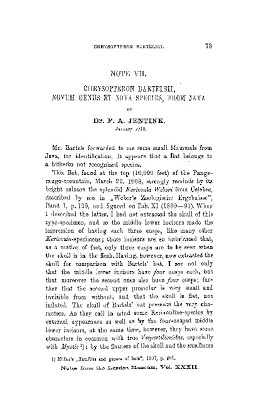1910
Chrysopteron Bartelsii, novum genus et nova species, from Java
Publication
Publication
Notes from the Leyden Museum , Volume 32 - Issue 1 p. 73- 77
Mr. Bartels forwarded to me some small Mammals from Java, for identification. It appears that a Bat belongs to a hitherto not recognized species. This Bat, found at the top (10,000 feet) of the Pangerango-mountain, March 22. 1908, strongly reminds by its bright colours the splendid Kerivoula Weberi from Celebes, described by me in „Weber’s Zoologische Ergebnisse”, Band I, p. 129, and figured on Tab. XI (1890—91). When I described the latter, I had not extracted the skull of this type-specimen, and so the middle lower incisors made the impression of having each three cusps, like many other Kerivola-specimens; these incisors are so imbricated that, as a matter of fact, only three cusps are to be seen when the skull is in the flesh. Having, however, now extracted the skull for comparison with Bartels’ bat, I see not only that the middle lower incisors have four cusps each, but that moreover the second ones also have four cusps; further that the second upper premolar is very small and invisible from without, and that the skull is flat, not inflated. The skull of Bartels’ bat presents the very characters. As they call in mind some Kerivouline-species by external appearance as well as by the four-cusped middle lower incisors, at the same time, however, they have some characters in common with true with Vespertilionidae, especially Myotis 1); by the flatness of the skull and the smallness of the second upper premolar, it is evident that Weber’s and Bartels’ bat cannot be brought under one of the named or other existing genera. I propose to create for their reception a new genus, viz.: Chrysopteron, n. g.
| Additional Metadata | |
|---|---|
| Notes from the Leyden Museum | |
| Released under the CC-BY 4.0 ("Attribution") License | |
| Organisation | Naturalis journals & series |
|
Jentink, F. A. (1910). Chrysopteron Bartelsii, novum genus et nova species, from Java. Notes from the Leyden Museum, 32(1), 73–77. |
|
